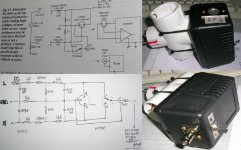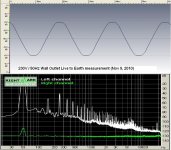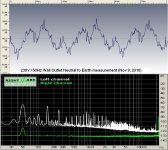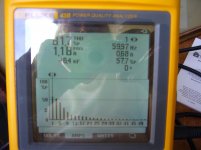Name the frequencies and where you want the "devices" connected. It's easy to do. .
PS, right after the transformer ....
I listened to an elaborate two-channel system that the resident Canoga Park audiophile (i.e., not me) said had BQPs in various strategic locations. He believed that they helped. He apparently talks to Bybee extensively.
I found the system sound adequate, very good but nothing overwhelming or extraordinary (big Sound Lab panels, a next-to-largest Bryston amp, the "completion" box that Atkinson recently reviewed and concluded was essentially a Blumlein shuffler, various source components). What amused me was the guy is still a total nervous nellie about excessive bass energy somehow getting to his panels and causing arc-over. So with any uncertified material (I brought a couple of CDs) he turns the level way down. Overall, he tends to listen at rather low levels I thought.
I should add that, had the system sounded extraordinary I'd have been suspicious, as quite frankly I've heard a lot of decent audio in good rooms, and IMO something that stands out generally does so because of anomalies, not competent design.
But I'm probably deaf too, as as much as I've wanted to hear the effects of some controversial accessories, and known when they were inserted or absent, I can't bring myself to hear an effect. Yet I can spot problems and diagnose them when they exist, and usually pretty accurately.
It worked, he's using Bryston amps .....
Et,tu, Jan? Oh well.
By the way, thanks for issue 3, and I did look through it. My original opinion stands, nothing new that I can learn or use in a serious way. Sorry.
You probably meant 'tu quoque, jan'. And yes. I get really p**sed off if people try to fool me with dishonest tricks and plain fraud. Funny you appear to accept that with no 2nd thoughts?
jan
Any interest to know what is actually made off a component that does nothing?So it really is just a resistor with floobydust around it!
Sorry, i had confused-you with Wayne, a prominent audio designer member of this forum. Hence my previous reference to measurements of digitally resistances array we previously talked together.PS, right after the transformer .... It worked, he's using Bryston amps .....
And my surprise to read some contents in your posts, under what i believed its signature.
Please (this wrote with a friendly intention) better give-it up yourself, on this subject. You could conclude by a "and still it moves" followed by a confused smiley and NEVER, NEVER talk of this any more.I give up on you, PMA. Too bad.
It would be a good idea to to remove those things from your system too, in case the scientific police arrives your home. And deny to be the real author of all your posts about BQP.
And ask men in black to visit us and erase our memories about your 'quantum' posts.
Last edited:
John.
If I told you I had something that went on your car and it was a little black box that went on fuel line and you would get an instant 100% increase in gas mileage you would question that I would hope. We are only doing the same thing here. You are not the one selling or making the bybee device so can't hold you responsible for it. But we are more than skeptical of any of these outrageous claims for something as simple as a black magic resistor.
If I told you I had something that went on your car and it was a little black box that went on fuel line and you would get an instant 100% increase in gas mileage you would question that I would hope. We are only doing the same thing here. You are not the one selling or making the bybee device so can't hold you responsible for it. But we are more than skeptical of any of these outrageous claims for something as simple as a black magic resistor.
Yes, I suspect the same. It would explain why bad cables are so popular, and possibly the 'groundside electron' nonsense. Inject a little RF noise, and add 'air' around the musical instruments.PMA said:It may add HF interference, and thus sound different. I would believe in such explanation more than anything else . Same is for some "special" cables. No microdiodes, just interference added.
Regarding 1/f "improvement". 1/f noise i easily measurable. Anyone measured 1/f noise reduction with Bybees inserted???
No, I showed explicitly that this doesn't happen. No one has presented any contradictory data (not surprising).
Well, you know, that's been one of the explanations of the "sound" of Class-D. The RF carrier does something to the wires, voice coils, whatever. Not a bad hypothesis.Inject a little RF noise, and add 'air' around the musical instruments.
I don't thing so. (And don't believe in 'something'). Just a switching amp has high slew rate, by definition.The RF carrier does something to the wires, voice coils, whatever.
Anything special with the sound of a good class D comparing with a good high slew rate non switching one ? They can be very similar in presentation.
Last edited:
It maybe "pixie dust" but it's not “Floobydust”.
In the 1976 National Semiconductor - Audio Handbook the word “Floobydust” is defined as:
“Floobydust” is a contemporary term derived from the archaic Latin miscellaneus, whose
disputed history probably springs from Greek origins (influenced, of course, by Egyptian
linguists) - meaning here “a mixed bag.”
Later in 1991 Bob Pease (RIP)(Staff Scientist at National Semiconductor) defined the word in his
Book “Troubleshooting Analog Circuits” as:
“Floobydust” is an old expression around our lab that means potpourri, catch-all, or miscellaneous. In this chapter, I’ll throw into the “Floobydust” category a collection of philosophical items, such as advice about planning your troubleshooting, and practical hints about computers and instruments.
Bob Pease often used the word in his columns in Electronic Design Magazine.
In the 1976 National Semiconductor - Audio Handbook the word “Floobydust” is defined as:
“Floobydust” is a contemporary term derived from the archaic Latin miscellaneus, whose
disputed history probably springs from Greek origins (influenced, of course, by Egyptian
linguists) - meaning here “a mixed bag.”
Later in 1991 Bob Pease (RIP)(Staff Scientist at National Semiconductor) defined the word in his
Book “Troubleshooting Analog Circuits” as:
“Floobydust” is an old expression around our lab that means potpourri, catch-all, or miscellaneous. In this chapter, I’ll throw into the “Floobydust” category a collection of philosophical items, such as advice about planning your troubleshooting, and practical hints about computers and instruments.
Bob Pease often used the word in his columns in Electronic Design Magazine.
Kindhornman, many phenomena cannot be easily understood, including type 2 superconductivity.
What's this Type 2 stuff? Everything Bybee has spewed about the BQP's has been straight out of the BCS theory of superconductivity, which as far as I'm aware, only appears to explain superconductivity in Type 1 superconductors, not Type 2.
se
No, I showed explicitly that this doesn't happen.
And even if it did, I've always wondered how it could discriminate between 1/f noise and a music signal.
se
That sort of AC 'clipping' appears to be an artifact of the display. I can get the SAME sort of 'clipping' from one of my early graphic calculators when showing a sine wave. Get real guys!
Only usual power mains network distortion. Measured thru 1:2 voltage divider.
This is from a series of utility’s 230V/50Hz measurement at my workshop.
The measurements were done with the “Live Probe” (built after an article in WW), the output of which was connected to M-Audio Audiophile USB sound card.
When the input is 230V, the output of the "Live Probe" has an amplitude of 687mV rms, which corresponds to the –6db in the measurements shown.
George
>Edit. The AC “clipping” (Flats at top and bottom peaks) is real. The higher the impedance of the utility’s branch and the lower the impedance of the connected equipment, the worst this clipping becomes.
On the FFT of Live to Earth measurement , the amplitude of the 3rd, 5th 7th and 9th harmonics is an indication of imbalance. So is the amplitude of the fundamental on the FFT of Neutral to Earth measurement.
Attachments
Last edited:
Perceived Sound...
Dan.
Ok, so did you try repeated (sighted) A/B testing and glean any sound differences ?.Just one, but John says I only have crappy midfi components and I'm deaf, so don't take it too seriously.
Dan.
then the circuit has a lot of second harmonic, AND DC in the mains.
Even harmonics are present when waves are non symmetrical. Such an asymmetry adds a DC component.
George
This is from a series of utility’s 230V/50Hz measurement at my workshop.
>Edit. The AC “clipping” (Flats at top and bottom peaks) is real. The higher the impedance of the utility’s branch and the lower the impedance of the connected equipment, the worst this clipping becomes.
On the FFT of Live to Earth measurement , the amplitude of the 3rd, 5th 7th and 9th harmonics is an indication of imbalance. So is the amplitude of the fundamental on the FFT of Neutral to Earth measurement.
This is farely common when old lines get added onto until overloaded. But the distortion isnt too bad for a clipped waveform.... 1% and less. But, there are plenty of HF harmonics to get past the internal power supply if not careful in design.
Now take a look at current waveform on the ac line with just a lamp dimmer turned on -- 82% THd and only 1 amp current draw. Even if you have great, clean - non clipped - ac power, you get this with just one consumer product on the ac line within the home. I have shown earlier that the spectrum can go out to many 10's of Mhz. These shown harmonic levels of the ac 60Hz are pretty high.
Attachments
Last edited:
- Status
- Not open for further replies.
- Home
- Member Areas
- The Lounge
- John Curl's Blowtorch preamplifier part II



